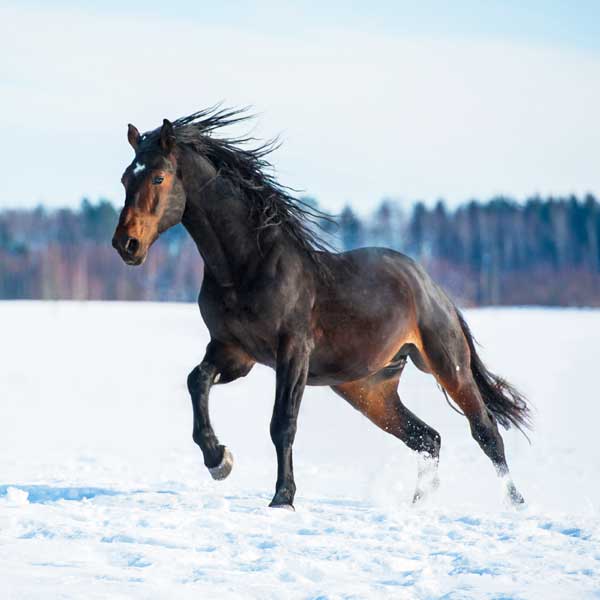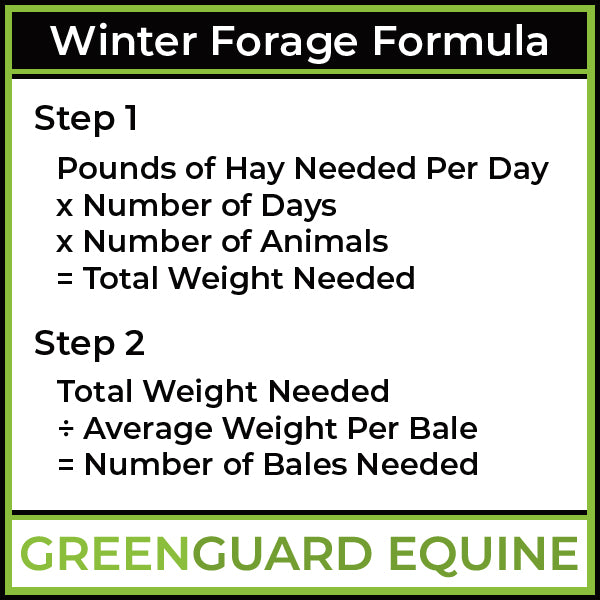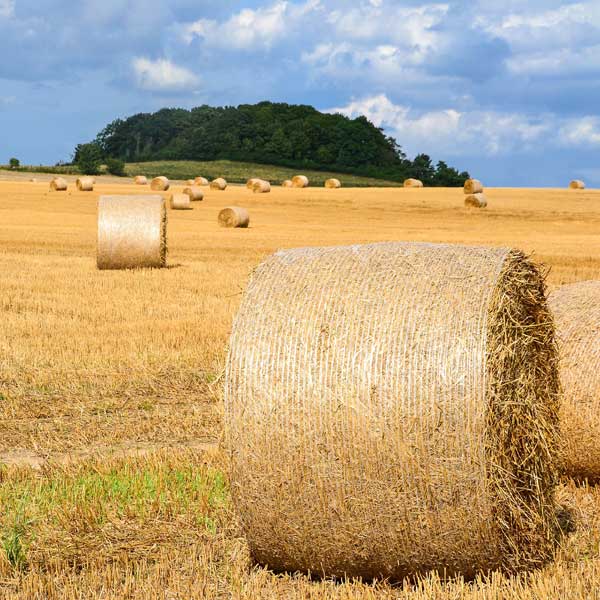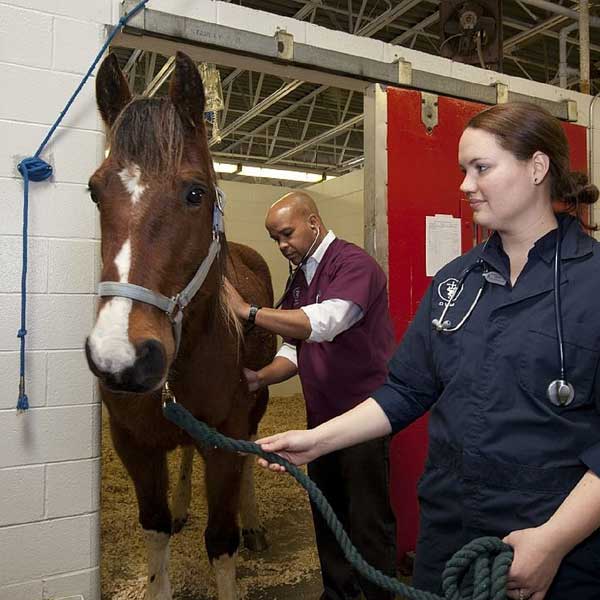For some horse owners, winter is something we look forward to. There are charming country rides past fields covered in white snow outside, while inside we cozy up around the fireplace and enjoy a mug of hot cocoa. Of course, standing between the rides and cocoa, there are the reasons that many horse owners dread wintertime. These include the fact that along with the season comes a load of extra work.
If you’re like me and live somewhere that has freezing temps, winter means dealing with ice. Lots of ice. It means breaking ice, picking ice out of horses feet, and, once the ice is melted, there’s the mud … oh the mud. Beyond trying not to track it all back into your house, there a bunch of things horse owners should be thinking about before the temperatures start dropping. Things like:
- Whether or not to body clip
- Hay storage and feeding habits
- Equine health care
- Hoof care and shoe maintenance

Grooming, feed, health care, and shoes: there's a lot to do to get your horse ready for winter! Photo by Grigorita Ko on Shutterstock.
Rather than being overwhelmed when the first snow comes, be prepared!
To Clip or Not to Clip
Don’t you just love the feeling of whisking away fluffy hair with a clean sharp pair of clippers? It’s very satisfying to go through the process of a full body clip and see a sleek, clean horse in the middle of winter. And let’s not forget the appeal of body clipping patterns and styles. Who hasn’t occasionally thought about clipping your favorite football team logo on your horse’s butt before the playoffs? But(t) before you get carried away, you should first consider your horse’s level of exercise and your workout or competition schedule to determine whether or not to clip.
Do you compete frequently in the winter months? Does your horse sweat a lot during your workouts? Does he take a long time to dry or cool down? If you answer “Yes” to any of these questions, then your horse probably needs to be clipped. Depending on the type of workouts and the amount of showing you are doing, you may only need to do a trace clip whereas others may require the full treatment.
There is one very important thing to remember, though, if you do decide to body clip your horse. For the rest of the winter, you will be responsible for blanketing your horse appropriately based on weather conditions. Even trace clipping compromises a horse’s ability to regulate their body temperature during cold weather. So if you are unable to attend to your horse’s blanketing needs daily, then you should not body clip. In that case, your horse is much better off with his own coat for protection and temperature regulation.

There are many considerations before body clipping your horse for winter. Photo by Chelle129 on Shutterstock.
Feeding horses through the winter
No matter where you live, or how much hardcore winter weather you get, figuring out your horse’s feed and forage situation for the season is not fun. It kind of feels like stocking up for Y2K at the close of 1999. But trust me, making those preparations in advance is so worthwhile. You don’t want to get to midwinter and find that all of your nearby suppliers are fresh out of your horse’s hay. It’s just as frustrating when they do have it, but can’t deliver it because the roads are undriveable.
What constitutes the best hay for horses in winter? When you’re shopping for hay, you want to find good quality hay that is green, leafy, and fresh smelling. Inspect it carefully to make sure that the hay you select is free of dust, mold, and weeds.
Horse feed and carbohydrates
Also consider your horse’s health in selecting the best type of hay. Certain grasses and therefore certain hays are lower in Non-structural Carbohydrates (NSC). Also, how recently the hay was cut and the cutting (1st, 2nd cutting) will affect NSC levels as well. Lower NSC forages are better for horses with Cushing’s and those prone to laminitis and founder. Here’s a great resource for understanding what types of carbohydrates are inherent to different kinds of feed.
In addition, some varieties of hay might not be able to provide all the vitamins and nutrients that your horse needs during the winter months. Consult with your vet on how best to provide your horse with a well-rounded diet. You may need to add supplements or grain to your horse’s diet if it is not sufficient.
Buying in bulk saves you money in the long run and keeps you supplied when the weather makes driving and deliveries difficult. So how should you calculate your forage needs, you might ask? The average horse eats 2% of its body weight per day.

Calculation Formula:
Pounds of Hay Needed Per Day x Number of Days x Number of Animals = Total Weight Needed
Total Weight Needed ⁒ Average Weight Per Bale = Number of Bales Needed
Hay storage: the risks of wet or infested hay
Getting enough hay is one thing, but storage is just as crucial. Store your hay in a cool, dry, well-ventilated place. Cover your hay bales as best you can, with a proper, waterproof tarp if possible. Water is your enemy when it comes to storing hay. Wet hay is a breeding ground for bacteria, mildew, and mold. Why are these things dangerous to your horse?
Practically every vital system in a horse’s body can be negatively impacted when they ingest wet hay that’s fostered bacterial or fungal growth. Horses can contract a wide variety of chronic disorder or life-threatening diseases from digestive disorders like colic to respiratory problems like heaves. Mycotoxins, which arise when mold is present, can affect a horse’s nervous system, reproductive function, the kidney, appetite, and immune system, and that’s just a short list!
Another facet of hay storage is keeping it away from little pests that can occasionally infiltrate the barn. Try to store it in a secure location, out of the reach of racoons and opossums. The natural instincts of these creatures is to avoid harsh weather, which is all good and well, but their feces and urine can carry a very deadly neurological disease called Equine Protozoal Myeloencephalitis or EPM.
These kinds of moisture-related problems with hay are not only harmful to your horse’s digestive system, but they also produce heat. This can lead to spontaneous combustion, and the last thing you want is a hay or barn fire.

Make sure hay is kept dry in a cool, well-ventilated space during winter. Photo by Anemone123 on Pixabay.
Finally, as with any new food source, you’ll want to take care to introduce it to your horse gradually. Even if it is a kind of hay they’ve eaten before, there are distinct differences in nutrient makeup with different cuttings. The changes between the first cutting of hay and subsequent harvests in the same season can be complicated.
Deworming
Deworming is an essential part of the health care routine for any farm animal. While it is true that there are fewer parasites in the wintertime, that does not mean that they disappear entirely. Depending on your local climate and ecosystem, horses may be at risk for different parasites at different times of year.If you haven’t worked out your equine worming calendar, there’s no time like the present to get on a regular schedule. Veterinarian-recommended schedules for deworming have changed substantially over the years based on new research so it is important to get up to date on the current recommendations. Here is a wonderful guide for what dewormers to use when and what parasites to test for.
Equine Vaccinations
Yearly vaccinations should always be a top priority for horse owners. Talking with your equine vet about your horse’s specific needs is a must. Common equine diseases vary substantially in different parts of the world, and even in different parts of the United States.
Of particular interest during the winter is botulism, which can be deadly to horses. Small vermin that sometimes get caught in the machinery during the creation of round hay bales, and their innards can release spores into the hay, which provide the perfect breeding ground for the botulism neurotoxin. No matter how well and securely you’ve stored your hay, if you draw your horse’s forage from round bales, your vet might strongly recommend inoculating your horse.

Consult with your equine vet to learn which vaccines are most necessary for your horse. Photo by skeeze on Pixabay.
If you travel to different places a lot with your horse, make sure they are up-to-date on their vaccination for Equine Strangles. As you probably know, Strangles is highly contagious and caused by a tough and persistent bacterium. A horse who is not symptomatic can carry and spread the bacteria for quite a long time. Make time to talk to your veterinarian about what is right for your horse.
Shoes or no shoes?
This is one of my least favorite parts about winter horse care. I’m always taken back to childhood memories of getting stuck breaking ice every year. Ice balls forming in your horse’s shoes can cause a wide range of issues, from imbalance and slipping to soreness and beyond.Although they won’t have to contend with ice balls like shod horses, shoeless horses aren’t much better off. Their feet can bruise easily on hard frozen ground. Whether shod or unshod, most horses’ feet are more susceptible to abscesses and thrush in the winter. This is only made worse with changing temperatures when ice and snow thaw for a while before refreezing.
More than any other facet of preparing your horse for winter, whether or not to pull your horse’s shoes is really up to you as the horse owner. You know best the quality of ground your horse will tread, along with your horse’s individual needs and tendencies. This is a case-by-case matter, and your farrier is probably the person you’ll most want to consult with.




